There's no such thing as "immigration law". But there should be.
Immigration law is different to other legal disciplines. It shouldn't be.
A total of 1.2 million migrants entered the United Kingdom in the year ended June 2023. What are the legal principles governing their entry and residence, their rights (if they even have any), their relationships, their removal, the journey home of them will take to citizenship? What are the principles of the structural legal framework governing immigration law, such as parliamentary and judicial scrutiny?
I’ve been an immigration lawyer for over twenty years and I don’t really know.
I gave a talk recently at the Public Law Project’s conference on challenging unfairness in the immigration system. The theme of the session I was talking on was immigration exceptionalism:
How and why is immigration being ‘exempt’ from traditional governmental and judicial oversight, allowing executive overreach into traditionally legislative powers? What impact does this have?
I took this as a chance to develop a theme about which I’ve been thinking quite a lot recently. Indeed, I started writing this Substack partly to address the issue.
Essentially, I argued in my presentation that there is no such thing as a distinct, identifiable legal discipline of immigration law. But there should be.
My point could be read as “immigration law should be more exceptional” in the sense that there should be distinct principles of immigration law and a separate body of law.
Or it could be read as “immigration law should be less exceptional” in the sense that immigration law should be more like other disciplines of law in that it should have its own body of jurisprudence and so on.
I put some effort into making the slides, so I’ll use them here to frame and explain what I mean.
One book
The only serious immigration law book is Macdonald’s, now in its tenth edition. But no-one reads it.
People do look at it and they certainly look things up in it. I do, and I’m sure others do as well. But I don’t think anyone other than the editors actually reads it, from cover to cover. It’s not a book from which you could or would learn how immigration law works as a whole.
There have been other books about immigration law. There is Clayton and Firth, an undergraduate-level textbook but one with flaws and an uncertain future. There have been very interesting books in the past like Subjects, Citizens, Aliens and Others by Dummett and Nichol and works by Prakash Shah, Satvinder Juss, Vaughan Bevan and a few others. All are out of print and few if any of them are read by anyone today.
There are quite a few immigration law adjacent books about immigration policies, essentially, particularly focussed on the racist past and present of immigration law. But these rarely explore immigration law as law. They may actually undermine the potential for the emergence of a body of immigration law because of their polarizing effect, a point to which I’ll return.
Compare this to the multiplicity of books published on asylum and refugee law. There are first wave publications now in later editions (Goodwin-Gill and Hathaway) but also numerous more specific works. There’s a mature body of scholarship on the subject. The same applies to human rights law and public law, the other two comparators I would ask you to have in mind as as you read this article.
One journal
There is a journal of Immigration, Asylum and Nationality Law and it has been around for quite some time. But it is not widely read by practitioners, as far as I know. There are few academics out there interested enough in immigration law to read it. It seems to have little impact. It certainly isn’t a great way to communicate ideas and establish norms.
Compare this to the plethora of titles on asylum law, human rights law and public law.
There is my own Free Movement website, which is quite widely read in the sector, but it is no substitute for a proper journal. With some exceptions, our articles are generally updates or “how-to” pieces, not long-reads or based on original research.
No conferences
Given I have given two talks on this subject at two different conferences both broadly on the subject of immigration control, this may seem like a bold and rather strange claim.
Legal and other professional conferences operate to inculcate and share ideas, challenge established norms and propagate consensus. They have social and anthropological functions as well, such as marking out a hierarchy.
We have virtually none of that in immigration law.
We did used to have a full-on Immigration Law Practitioners’ Association AGM on a Saturday once a year, but no longer. It’s now a weekday afternoon affair with a literal dial-in option. We do have specialist conferences on business immigration and immigration law-adjacent conferences like the ones at which I’ve given the presentation of which this article is an extended version. The most recent was organised by the Public Law Project with the aim of understanding why immigration law has the temerity to think it isn’t public law. Which I think kind of proves my point.
No academic centres
Immigration law does not, as far as I can see, stand alone as a distinct academic discipline. There are very few academics interested in immigration law as law as well as policy.
I’m not saying that law and policy can be separated. But I think it might be possible to study the structure of immigration law and consider questions like whether it has or should have distinct principles. There would be policy outcomes to such an exercise, I feel. We might have more chance of achieving a consensus and embedding real change if we started with legal structures rather than starting with policy outcomes.
Returning to my earlier point about comparators, think of the Refugee Studies Centre at Oxford, the Michigan Law School, the Refugee Law Initiative in London, the Kaldor Centre in Australia and the Refugee Law Project in Uganda. There are similar centres of study in human rights law and public law.
There is the Migration Observatory, which does excellent work, but its focus is very much on statistical analysis and presentation.
I have deliberately chosen an image of Leicester University here. Bernard Ryan is based there as is Alan Desmond, editor of the one journal we do have. And there is an optional immigration law module available to undergraduates at Leicester, along with a handful of other universities. But there’s virtually no-one studying immigration law at post-graduate level, as far as I know. What is there even to study, in legal terms?
No immigration lawyers
Given I self-identify as an immigration lawyer, this too will seem like a strange claim to make.
I would argue that most “immigration lawyers” are really really asylum lawyers, human rights lawyers or public lawyers. Or want to be.
This is where the work is, due to the abolition of immigration legal aid in 2012 and of immigration appeals in 2014. All that is really left is learning the immigration rules and filling in forms.
This is where the glamour is. Want to be an “activist lawyer” or “lefty lawyer”? Want to challenge state power, irritate Patel/Braverman/Cleverly [delete as appropriate] and get into arguments with the few remaining black cab drivers? Want to attend conferences, write journal articles, contribute to books, act in the big cases? That’s where it’s at.
And this is where the money is. It’s not that asylum, human rights or public lawyers are motivated by money. If they were, they’d go off into a genuinely lucrative area of law. But there’s basically zero money in normal immigration work beyond the form-filling stage. For which lawyers do, admittedly, sometimes charge rather a lot.
There are a few wealthy individuals who need representation. There are sometimes families or individuals for whom it makes more sense to appeal or judicially review than to make a new application. But these cases are very few and far between.
I think there is something interesting and counterintuitive to be said and written about how human rights law has proven to be damaging to migrant’s rights, but that’s for another time and there’s certainly a strong counter-argument there as well.
Perhaps my argument here is actually that there are no immigration barristers. Because there are precious few immigration appeals these days. There are loads of solicitors and OISC advisers doing day-to-day immigration applications for the very considerable number of regular “inside the law” migrants coming to the United Kingdom. But they operate in a legal singularity. There is such a heavy density of raw, principle-free “law” in the form of forms, guidance, rules, regulations and statutes that, crushed by its own mass, it is veiled by an event horizon.
No international conventions
In some other areas of law, international conventions can provide a framework from which principles and perhaps a whole jurisprudence can be derived. This is surely the case with refugee law, human rights and EU law, and with international law as a whole.
Immigration is considered to be almost entirely a matter of national sovereignty other than where it impinges on certain very minimal human rights.
There is the International Convention on the Protection of the Rights of All Migrant Workers and Members of Their Families 1990 but the UK is not a signatory.
There are migration elements to the General Agreement on Trade and Services and some other treaties and conventions that impart rights to migrants or obligations on states.
I’m not saying that there should be or needs to be an international convention on immigration law. Immigration is inherently national in nature, although surely there are commonalities and there have previously been treaties on issues such as long residence. What I’m saying is that the absence of a convention means we lack a peg from which to hang a ready-made framework.
No autonomy
It is not clear how, if at all, immigration law differs from administrative law. Indeed, this was implicitly the subject of the Public Law Project conference at which I gave the presentation on which this article is based.
The thing is that lawyers certainly find that in practice immigration law does not conform to normal public law principles. In practice, we can be pretty sure that immigration law is different to public law. Arguments that would be good in a normal administrative law context seem bad or unreliable in an immigration law context. The same goes for human rights law and family law.
The state seems to get away with a lot more in immigration law, basically. For example, why is it that “abuse of process” is defined by judges as it is, so that the objectives of one party to an immigration case are automatically deemed illegitimate but not the other? One side might be attempting to stay in the UK, perhaps in bad faith. The other side is attempting to force the other out of the UK, also perhaps in bad faith. Both are wasting court time and the resources of the other party. But they are certainly not treated alike.
We don’t publicly talk or write about this or other slightly mysterious, unspoken exceptions to norms. Speaking for myself, I’m so inured to the exceptions that I can no longer see the wood for the trees.
Maybe it is time to start spelling out the differences, even if we don’t initially much like the resulting words and sentences. Perhaps, once those sentences exist, we can adapt and rephrase and rewrite them over time.
No principles
What even are the principles of immigration law? I can’t think of any well-known or established ones. Other than almost total executive discretion, bounded only by a fragile culture of compliance with international agreements and some leaky public law principles. This, coupled with a high degree of judicial deference to executive power.
If we look to the roots of what in other contexts might be considered an astonishing degree of control by the Home Secretary, we can see there is some room for debate about whether this is the best way to do things. Essentially, immigration control was introduced in emergency wartime legislation in 1914 that was literally two sections long, one of which is the citation. It was then, fatefully, extended into peacetime in 1919 because that was the easy option. This system was only reformed in 1971, and arguably only partially.
If we get into the weeds, there are some rules that have been around for a long time, such as sole responsibility or subsisting marriage or maintenance and accommodation. But the time before them is long forgotten and we just accept them unquestioningly. We can explain them but we don’t interrogate them.
The sole responsibility rule, for example, is about a presumption that children should not be admitted unless absolutely necessary. It’s not about their parent’s wishes or the children’s best interests, although some of that has been badly retrofitted to the concept. We don’t talk about whether that is the right approach any more.
And all these rules could be scrapped tomorrow, which is itself a curious feature of immigration law. After a brief moment of surprise, we’d all just carry on as normal, learning the rules and filling in forms.
What law should be in primary and what in secondary legislation? How should immigration rules be formulated? What should be in immigration rules and are quasi-statutory “rules” the best solution or an inappropriate hangover from the equivalent old, unpublished guidance dating back to the emergency wartime days? Is there a better structural way to balance the need for flexibility with the need for certainty and input from actors other than the Home Secretary? Who should have a say and how, from in government or outside? What is the proper role for parliament and can meaningful scrutiny be built into the system? What should the “immigration journey” be, what is it for and should it be different for different migration routes? What is the “probationary period” really for? Should there be limits to executive discretion and if so, what and how? Should such limits come in the form of enforceable individual rights or legislative handcuffs? Given in-country immigration control is largely tokenistic, how should enforcement discretion be exercised or controlled? What functions of control can be privatised and with what regulation? What should be the principles of internal immigration controls? How should unauthorised migrants be treated given they cannot, mostly, be removed? What level of interference with family life is permissible in an immigration context? Should citizens have different rights to settled migrants? Is immigration contractual and does this mean that migrants are deemed knowingly to sign up for whatever is in store or can the government change the terms on them after entry?
These questions are off the top of my head. There are plenty more out there, I’m sure.
No “community of law”
A “community of law” is
“A partially insulated sphere in which legal actors interact based on common interests and values, protected from direct political interference”
Laurence R. Helfer and Anne-Marie Slaughter (1997) ‘Toward a Theory of Effective Supranational Adjudication’, Yale Law Journal 107:2
I came across this idea when I was researching a textbook on refugee law. I suddenly realised that I was part of such a community and had been for over two decades, without really thinking about it. I wrote journal articles, attended conferences, gave talks, delivered training and so on. The community of refugee law is both national and international.
Here’s a slightly extended definitition:
“a network of subnational and supranational legal actors (lawyers, judges, and legal scholars) with independent channels of communication; a set of incentives encouraging these actors to interact with one another and to maximize the impact of supranational decisions; and a set of norms distinguishing law from politics in ways that promote an autonomous realm of law protected from direct political interference.”
There are three elements there:
The network of people.
Means of communication which actually work – hence the references to common interests and values, and also to incentives. Incentives probably need to be financial in part (lawyers need cases, academics need funding) but also social, such as prestige.
As set of norms or principles with some degree of consensus. In asylum law and practice, there has been said to be a “dual imperative” to perform according to one’s professional standards but also to advance the protection of refugees. This itself has provided some political insulation because the community tends to be broadly like-minded, or at least to have common aims. If you’re into this stuff, there’s another really interesting article well worth reading by Rosemary Byrne and Thomas Gammeltoft-Hansen called International Refugee Law between Scholarship and Practice.
In immigration law we now lack the network of people, the means of communication and the set of norms. There is no “community of immigration law.” Maybe there was a nascent community back in the 1980s and early 1990s. A literature certainly started to develop at that time. But if so, it withered and died.
One issue is that the single practitioners association that exists for immigration lawyers excludes around half of all immigration lawyers: the ones who work for the government. The objectives and articles of association arguably make this exclusion formal but, in any event, there seems to be an informal bar.
I don’t really know how other areas of practice operate and they might be similarly polarised, so perhaps this is a bad point. And there’s certainly no criticism of ILPA intended here. I’m absolutely in favour of claimant lawyers being able to congregate and compare our battle scars. But I’ve started to wonder whether some common space to interact with government lawyers might be useful. It might serve to establish some common ground in other respects.
Perhaps, in order to develop a meaningful, distinct and durable discipline of immigration law, we need a proper community of immigration law.


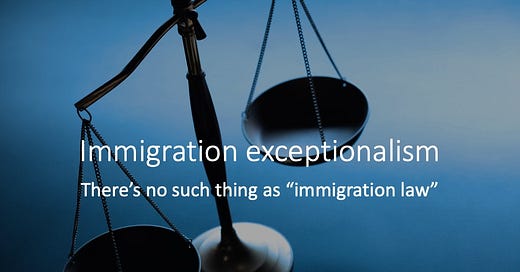


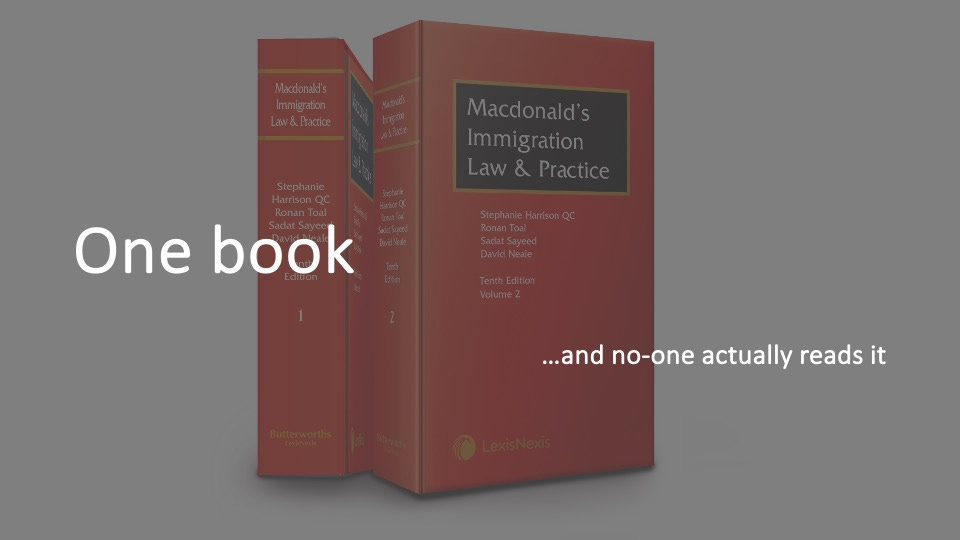
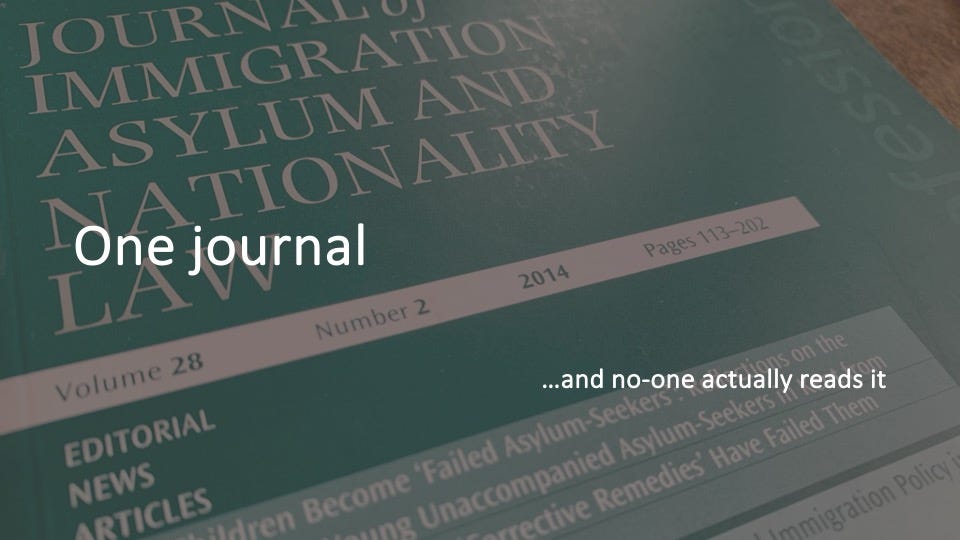
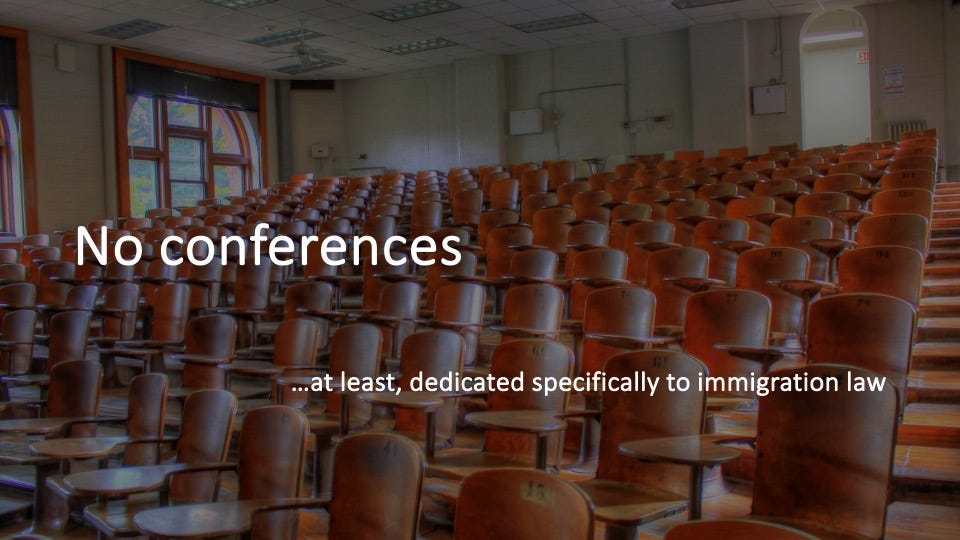

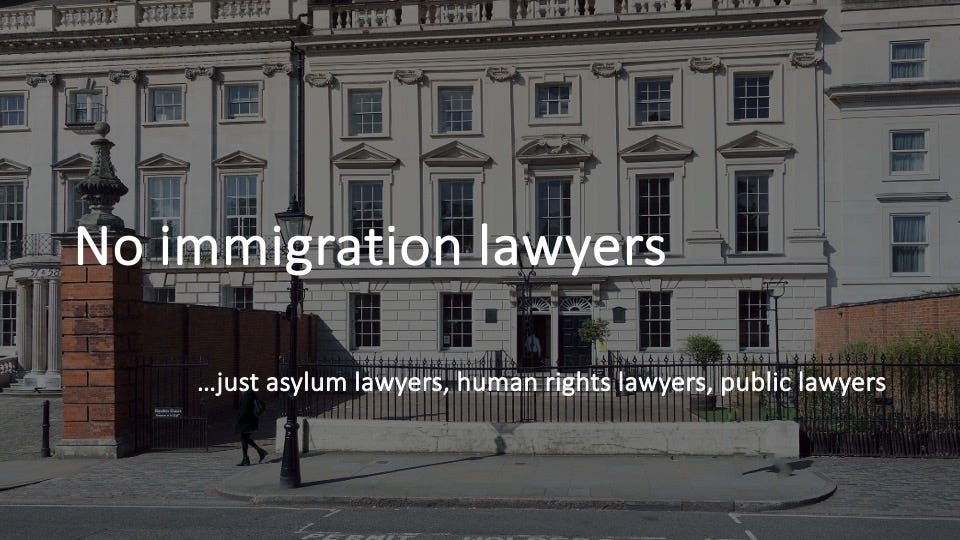
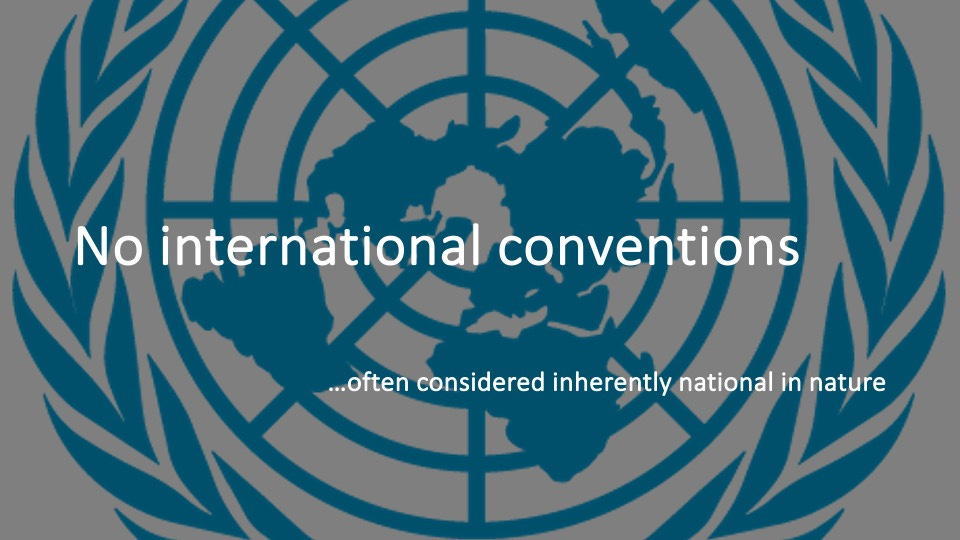
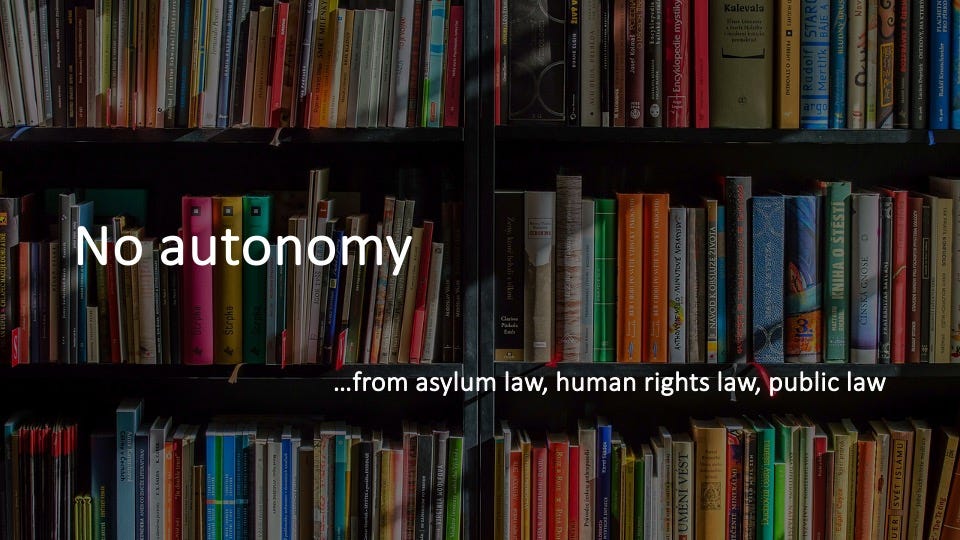


Interestingly, a new case from the Court of Appeal illustrates some of the central points I was trying to make in this article. It arose from the legacy of the EU's data protection regulation, which was cut and pasted into UK law upon Brexit. EU legislators tend to be serious about privacy, scrutiny, clarity and so on and it turned out that the UK government's preferred home-grown approach to immigration law was inadequate when measured against those standards. The case is R (On the Application Of The 3Million) v Secretary of State for the Home Department [2023] EWCA Civ 1474:
"45. ... The rule of law has been recognised by Parliament to be a "constitutional principle": see section 1(a) of the Constitutional Reform Act 2005. The exact requirements of that principle are not always clear, although a magisterial analysis of the concept is to be found in Lord Bingham's book, The Rule of Law (2010). It seems to me that of particular relevance in the present context are three fundamental principles which can be discerned in the jurisprudence, including the judgment of this Court in the first claim for judicial review.
46. The first is the need for "specific" provisions rather than general principles of human rights or administrative law. This requirement of specificity is important in this context to reduce the risk of abuse of broad powers. But it might be said that this first principle could be satisfied by having a non-statutory policy document provided it has a sufficient degree of precision. This leads me to the second fundamental principle in this context.
47. This is that it is necessary in this context for there to be binding rules of law rather than simply policies. This will be true even if in general the policy must be complied with as a matter of public law.
48. At the time of this Court's judgment in the first claim for judicial review, the Court was concerned with the EU GDPR, which referred to "the legislature". This explains the references to "the legislature" in the judgment of Warby LJ, for example at para 50. The UK GDPR refers instead to "the Secretary of State". At first sight this might be thought to indicate that the Secretary of State is free to enact the safeguards required in any form that he chooses. That, however, would be inconsistent with the express language of Article 23(3), which makes it clear that the Secretary of State may exercise the power in Article 23(1) "only by making regulations under section 16 of the 2018 Act."
49. Furthermore, section 16(3) provides that regulations under that section are subject to the affirmative resolution procedure. This leads me to the third fundamental principle in this context, the importance of the role of Parliament.
50. Taken together, these provisions make it clear that Parliament has an important role to play in this context. They provide for democratic scrutiny by Parliament of the measures which the Executive invites it to approve. If it were open to the Executive to acquire powers in this context without setting out the safeguards in a document which also has to be approved by Parliament, that would risk undermining both the effective democratic scrutiny of the measure and the rule of law. If, for example, the safeguards could simply be contained in a policy document such as the IEPD, those safeguards could be amended or even abrogated subsequently without the need for the Executive to return to Parliament for its approval."
https://www.bailii.org/ew/cases/EWCA/Civ/2023/1474.html
Lord Justice Singh goes on to say that none of this need lead to "undesirable rigidity", which is certainly something to be avoided in immigration law.
Imagine this approach being applied to immigration "law", such as it is. We'd have a set of rules that provide for specifics rather than general human rights or administrative law fall-backs, criteria would be set out in binding rules rather than fleeting policy documents and parliament would play a greater role, ensuring proper scrutiny and safeguards.